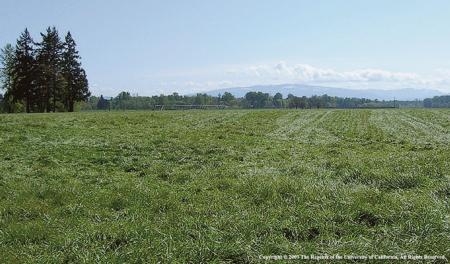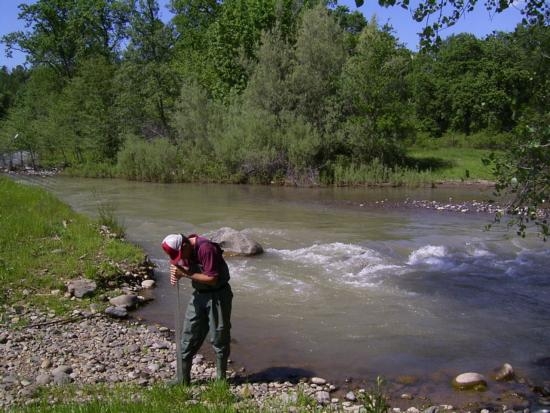
Posts Tagged: Larry Forero
It's raining in California, but drought concerns haven't been quenched

A story in the Los Angeles Times this week opened with the concerns of cattle ranchers. Without winter rain rangeland grass doesn't grow. Ranchers must decide whether to buy expensive feed or cull their herds to weather the drought.
"Their struggle is a bellwether for California's $45 billion agriculture sector," wrote reporter David Pierson. The repercussions will be felt beyond the state's borders. "The Golden State produces nearly half of all U.S.-grown fruits, nuts and vegetables and is the nation's leading dairy and wine producer."
Pierson quoted Doug Parker, director of the UC California Institute for Water Resources, in his article.
"The agriculture industry is definitely hit the hardest by drought," Parker said. "In California, agriculture uses 80 percent of water in the state. It's a major input for their business and hits their finances and employment directly."
The San Luis Obispo Tribune reported on drought hardships for SLO County fruit and vegetable farmers. Growers are facing increasing irrigation costs and taking steps to reduce salt buildup in the soil.
"The drought forces growers to prioritize crop cycles,” said Mary Bianchi, UC Cooperative Extension adviser. “What do you plant, and what do you leave fallow?”
In Stanislaus County, ranchers are expressing concerns about a trend among farmers toward planting almonds, reported the The Modesto Bee. Ranchers are worried the spread of almonds, walnuts an other high-value crops could strain their limited groundwater, drive up land prices and intrude on their way of life.
“It's not hard to understand why (farmers are planting more almonds),” said Roger Duncan, UCCE advisor. “It's very profitable.”
It was Duncan who provided the rough figures on almond profitability during the first day of the ninth annual summit of the California rangeland Conservation Coalition recently, wrote Bee reporter John Holland. Duncan said the net is even better for walnuts, which are not as extensive but still have had major growth in acreage. He also said the nut boom could be limited by a shortage of water and land.
The Drovers Cattle Network reported that cattle ranchers are seeking strategies for surviving the drought.
According to the article, rancher Billy McDonald's wife, Aileen, said she learned from UC Cooperative Extension farm advisor Glenn Nader that "you need to set a date, like if it doesn't rain by a certain date, to start culling. That's really important."
Also as part of the story, Roger Ingram, UCCE advisor in Placer and Nevada counties, advised ranchers to develop a drought plan.
Ingram warned against overgrazing and emphasized the importance of leaving enough residual dry matter in the ground to enhance seed germination and minimize soil erosion. With more bare ground, water would run off instead of soaking in, he said, and there would be less organic matter to feed soil microbes, resulting in fields being overrun by undesirable plants such as medusahead and yellow starthistle.
"Your grazing strategy should be take half, leave half," he said.
For those who are on irrigated pasture with limited water supply, UCCE advisor Larry Forero said fields are the driest in the summer but can get by with less water in the fall, so irrigate as close to evapotranspiration as possible and then stop irrigating. He also advised leaving four to five inches of stubble to facilitate pasture growth in the fall, should it rain or irrigation water become available.
UCCE plans meeting to help producers with new water rules

Before the new law took effect, the water board asked landowners for estimates, said Allan Fulton, a University of California Cooperative Extension advisor who serves Colusa, Glenn and Shasta counties. Fulton is an irrigation and water resources expert.
"There is a statewide effort at trying to more precisely understand and quantify how water is being used," he said.
UC Cooperative Extension will host a workshop March 31 to discuss the new requirement.
"I've had enough questions that I thought we ought to organize something," said Larry Forero, a UCCE director and advisor in Trinity County who specializes in livestock and natural resources.
Agritourism generates income, promotes farms
Tim Hearden, Capital Press
Agritourism, or activities and products offered on working farms to generate extra income from visitors, is a growing movement in California.
A recent UC survey determined that about 2.4 million visitors came to California farms in 2008 to enjoy some facet of agritourism, which could include lodges and cabins, pumpkin patches, corn mazes, "U-pick" operations and special events such as weddings and conferences.
"I think it really does help" farms, said UC agritourism coordinator Penny Leff. "It helps their name recognition if they're selling at the farmers' market or local stores. It helps in general for people to understand what farming's about, that food comes from farms."
Redding newspaper article features new Shasta CD
The Redding Record Searchlight ran a story last week introducing Shasta County residents to their new UC Cooperative Extension director, Larry Forero. Forero replaces Gary Nakamura, who retired in June after 27 years as a forestry specialist - the last four he also served as county director.
The story noted that Forero, 50, has been the UCCE livestock/natural resources advisor in Shasta County for 20 years and will continue in that role in addition to his county director duties. Forero grew up in Weaverville and earned a bachelor's degree in agriculture from Chico State University, a master's degree in range science from Colorado State University and a doctorate in wildland resource science from UC Berkeley.
Forero told reporter Laura Christman that he isn't planning big changes for the local Cooperative Extension service. He expects his biggest challenge to be the tough economic times.
"Like every government entity at this instant, we are trying to figure out what the state budget is and how that is going to play back out in the counties," Forero was quoted in the story.
There are three advisers — livestock/natural resources, nutrition/family/consumer science and crop science — serving Shasta and Trinity counties. Nakamura's forestry specialist position is not expected to be refilled.
With a smaller staff, Cooperative Extension has had to change its approach, Forero said.
"We are doing a lot of webinars and online workshops to compensate for reduced support for face-to-face workshops and field meetings," he was quoted.

Larry Forero checks water transparency of Cow Creek. Photo by Lisa Thompson.